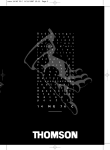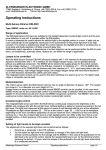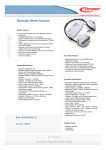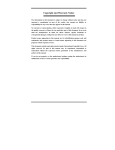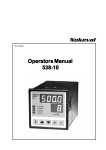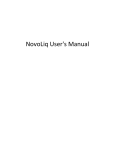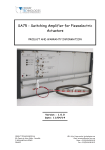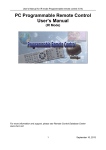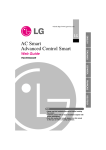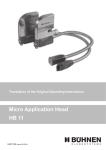Download Operators manual Nokeval
Transcript
Nokeval No 17298 Operators manual Indicators 440 and 441 1 Manufacturer: Nokeval Oy Yrittäjäkatu 12 FIN-37100 NOKIA Finland Tel. +358 3-342 4800 Fax. +358 3-342 2066 2 Panel meter 440 and 441 Display of 2 channels, A, B 2 input channels Output: - galvanic isolation - 0/4..20 mA - 0..10 V - 1..5 V Channel A 800.0 K1 Nokeval K2 Channel B Alarm relays - max 240 VAC, 2A Both channels accepts different kind of sensors. Sensor types: Thermocouples RTD Current 0/4..20 mA Voltage 0..10V or 1..5V Potentiometers 25, 50, 500 ja 1000 mV inputs Strain-gauge sensors Programming via front panel keys: All inputs and outputs can be programmed and modified from the front panel. Output and serial card as an option. General description Indicators 440 and 441 have two separate input channels. Model 440 has 14,5 mm digit height and case 48 x 96 mm and model 441 respectively 25 mm digit height and case 72 x 144 mm. You may set to both channels functions like square root, logarithm, subraction, sum, etc. The channel, showing the calculation, may also have its own functions. You can freeze the automatic scanning or use only one channel. You can realize many applications without separate transmitters f.ex. differential temperature measurement or temperature compensation in flow metering. Four digit display (-999...+9999) has a resolution 1/32000. Smallest range (20 mV) has resolution of 0.7 µV. Floating decimal point widens display range within resolution limits. All settings are stored in non volatile EEPROM. Inputs: Both channels accept different input f.ex. channel A may have Pt100 sensor and channel B thermocouple K. Small mV ranges are 20, 50, 500, 1000 mV and scaleable current ranges 0/4..20 mA, voltage 0..5/10 V and 0..1V. You can teach on site indicator to remember real path of a potentiometer. 440/441 accepts strain gauge input; 20, 50, 500 mV, but as presetted, factory calibrated. In this case indicator has only one input channel. Scaling is affected by front panel keys. Various sensor types are stored in memory and are freely programmable. 3 Alarms: meter replaces transmitters by using output card. If output card is not used, you can get 24 VDC supply for 2-wire transmitters. You may customize output signal f.ex. by adjusting recorder scale by front panel keys. You can set two separate alarm levels to each channel by front panel keys. Meter has two relay alarms which may be set to each channel or also to math function channel. Relays can control line voltage (230 VAC) devices. You can program low or high alarm. Reset function is also available. With alarms you may realize special functions like comparing which channel is larger and giving relay information about relation of inputs. Serial output RS232 or RS485 Serial output is alternative for analog output. Meters can be connected parellel to serial cable and their content are to be read. Firstly you send an addres and thereafter the meter with that address answers by giving number of channel in question. Serial output is galvanic isolated. Output signal Standard output card 0..20 mA, 4..20 mA, 0..5 V, 1..5 V and 0..10 V as option. Either input channel or function channel can get output signal which is galvanic isolated from input signal. In many applications Math functions: 980.0 log x ln x a-b etc. Display 9999 Channel A Alarms X CPU Channel B Input circuits: - mux - gain selectors - autocalibration - A/D converter X log x ln x a-b etc. Keys on front panel X Output: 0/4..20 mA 0..10V log x ln x a-b jne. Serial data RS 485 RS232 Power supply 24 VDC for 2-wires +-5 V Power supply 4 Channel B Connections: 5/10 V Thermocouple and mV-input: Contacts: selectable NC or No mA Input: 0/1..5/10VDC: TC mV + - Pt100 3-wire. Alarms max. 240 V, 2 A Pt100 2,3 tai 4wire + K1 K2 Current 0/4..20 mA: B + - c + + + - c ++ Pt100 4-wire. + Potentiometer: Pt100 2,3 4wire N 4..20 mA or 24VDC + TC mV Pt100 2-wire. Output (V) 0/1...5/10 V + - A Output (mA): (0) 4..20 mA 0/1-5/10V Note 1 ja 2 L Power supply 10 ja 12 Standard: 220 V AC mA 5/10 V Channel A Connections for channel B as channel A. Note 1. Output 0/1..5/10 : Connect jumper to connectors 7 and 19. RS-232 and RS-485 connections in page 20. Note 2. Power supply 24 DC (non-regulated) for 2- wire transmitters from output connectors 7(+) and 8(-) if output not used. Connection of remote contact Power supply: Standard 230 VAC, others 110, 24 VAC or 24 VDC 24 VDC = (connectors) 12(+) ja 10 (-). Use of remote contact You may use remote contact in taring the display, in seguential calculating of average value etc., depending on program version and selected function. You can create the same function by pressing simultaneously the both arrow- keys on front panel. Two Pt100 sensors can not be used when remote contact function is selected ( Pt100 sensor on Bchannel only). Power supply Closing contact Remote contact function is optional and must be mentioned in order. 5 Dimensions: Model 440 145 96 48 145 Relays Inputs Channel B Cut out 43.5 Power supply Channel A 90.5 Connectors , max. 2.5 mm2 Model 441 145 144 72 145 Inputs Relays Channel B Cut out Power supply Channel A 136.5 Connectors , max. 2.5 mm2 6 66.5 2-wire transmitter connection power supply, are connected normally. Extra card provides one galvanic isolated output. In this case, internal 24 VDC power supply for 2-wire transmitter can not be used. You can connect 2-wire transmitters direct to input without separate power supply. Meter connectors supply unregulated 24 VDC, max. 50 mA, for 2-wire transmitters. Active transmitters, having their own Connection of 2-wire transmitter using external power supply Indicator 440, 441 Channel B + Power supply 24 VDC + - 2-wire transmitter Channel A Power supply + Connection of 2-wire transmitter without external power supply Channel B + +- 2-wire transmitter ChannelA + Power supply Power supply 24 VDC: terminal scews 7(+) ja 8(-). 7 Technical specificatios Mathematical functions: You can set separate functions to channel 1 and 2. The third channel displays the calculation between input channels 1 and 2, f.ex. difference, sum, average, square root etc., according to a separate table. All 3 channels may have output signal. However, only 1 output signal at a time. Input channels: 2 separate, differential input channels. 2-, 3-, or 4- wire connection, depending on sensor. RTD- sensor Pt100: Range -200...700 °C Resolution 0.1 or 1 °C Accuracy 0.05 % or 0.1 °C by 4-wire conn. Accuracy 0.05 % or 0.2 °C by 3-wire conn. Differencies between channels max. ±1 °C Line resistor effect 0.005%/W (3-wire) Temperature drift negligible. Output signals: Ranges: 0..20 , 4...20 mA, 0..5. 1...5, 0..10 VDC. output signal is scaleble over whole display range. Each channel may have different values. Configuration via front panel keys. Accuracy 0.05% of display. The output signal is isolated. Max load 600 W. Thermocouples: K -100...1250 °C J, J/DIN -100...+900 °C T -50...+350 °C E -50...+350 °C R,S 0....+1700 °C Accuracy 1 °C ±1 digit S,R: 2 °C ±1 digit Sensor wires have no effect below 1000 W. Cold junction effect below 0.05 °C/°C. Alarms: 2 alarm levels to be set to any channel and if desired, to steer 1 or 2 relays. 2 relay outputs, 240 VAC, 2 A, closing or opening contact to be set K1 or K2 alarm. Freely selectable hysteresis. Programmable or automatic reset (on/off function). Input signal 0/4...20 mA: Scaleable range -999...+9999. floatting decimal point 0.001...9999. Input resistance 50 W. Accuracy 0.05 % of range. Serial port RS232 or RS485 serial port on a separate card. Severtal indicators may be connected to the same serial cable. You can not use serial port simultaneusly with an analog card. Voltage inputs: Scaleable ranges: 0-1, 0-5, 1-5, 0-10VDC on range -999...9999. Input resistance 1 MW General information 2 freely programmable input channels. 4 digit, red, 14 mm, LED display Configuration via push buttons on instrument front. Case 48 x 96 x145 mm and 72 x 144 x 145. Operating temperature -5...+50 °C Storage temperature -40...+70 °C Removable connectors, max. 2.5 mm² Line voltage 230VAC, 50/60 Hz as a standard, 110, 24 VAC or 24 VDC as an option. Weight 900 g. Voltage ranges: 20, 50, 500, 1000 mV. Input resistance 1MW, ranges 500 and 1000 mV. Input resistance 10 kW ranges 20 and 50 mV. Floating decimal point. Accuracy 0.05% of range Potentiometer inputs: Potentiometers 25...1000 W as standard, 1..10 kW as factory calibrated. 440 can be teached to remember min/max. position of pot and save it in memory. Settings via instrument front panel buttons. You can scale display to desired range, not depending on teaching function. Factory calibration to desired pot. value. 8 Instrument front panel Channel lights A , B and AB Alarm lights Push buttons You can change display values by up- down (arrow) buttons in programming state. A K1 B 9800.0 K2 Conf Indicating light CONF informs always that display does not show measured value. Instruments is in configuration stage and you can change settings. Nokeval Reset of min/max. value: Stop channel. Press both arrow keys simultaneusly. Only chosen channel (A, B or AB) will be reseted. Change of channel When you press *-key channel changes in order A, B, AB and then automatic scanning starts. When CONF indication blinks and A led lits, display shows A-channel and when B light is on channel B is in display. When both indication lights lit display shows third channel AB, f.ex. subtraction A-B. Interruption of automatic scanning returns display always to channel A. Eerom reset: If You want to reset all settings it can be done by holding down the *-key and connecting simultaneously supply voltage. Display shows CodE and waits for access code, enter 1919 with arrow keys and press *key, (You may still exit by switching power off). After reset text Conf appears to display, unit is in configuration mode. Eeprom reset clears all information from memory and configuration must be done from the beginning. Alarm settings Checking of alarm value Indication light start to blink and display shows alarm value. K1 K2 A B 9800.0 Conf Nokeval Setpoint changing: Stop automatic scanning by pressing *-key. Press arrow key K1 or K2, display shows alarm level. Press simultaneusly *-key until symbol Conf starts to blink. When both indication lights blinks you can change set point by arrow keys. Select first the channel which alarm level you like to change. Reset functions of alarms: If manual reset is selected, press arrow-key for reset. Reset K1 = up-key Reset K2 = down-key Setting: Change blinking number (0..9) by arrow keys and move to next number by *-key. When all numbers are changed blinking stops and display shows set point. Exit by pressing *-key or you can start from begining by arrow key. 9 Configuration You can configurate the meter by three push buttons on meter front. Display will show symbols, which can be changed, or the settings that may be controlled only. *-button will not change settings but it transfers display and program to next stage. Select configuration stage by pressing both arrow buttons and the *-button at the same time. CONF-text appears on the display. Now you are ready to start configuration. Common settings Display You can select the number of channels, output etc. Buttons CONF Turn off lights A ja B by arrow keys and press *-button. br 7 SP dS (0) Brigthness control 0..15, 15 = brighest. Display scanning time between channels, 0...7. 0 = fastest. How many measurements will be displayed, max 7 samples/ second/ channel. You can damp the fast changing display by dS-function (0...7). 0= each measurement is displayed. 7 = seven measurement are skipped. Output signal 0/4..20 mA or 0/1..5/10VDC, 0=not in use, 1=in use. Relay K1 Contact: nc= normal closed, no= normal open Relay K2 Contact: nc= normal closed, no= normal open Select line 50 or 60 Hz (default 50 Hz) Select baud rate (only for serial output) Select serial output protocol: EE=1, continuous transmit e.g. to displays (master). EE=0, answers only when asked (slave). See pages 20..21. Serial address 0..99, only when EE=0 (i.e. slave function). Potentiometer (page 17) and output (page 18) calibration. Function selections must be made before in Channel settings- mode. xx = 11 Potentiometer calibration, channel A xx = 12 Potentiometer calibration, channel B xx= 21 Output calibration, 0/4..20 mA xx= 22 Output calibration, 0..10 V oU 0 1 no 2 no F 50 4800 EE 0 SA CCxx (0) Secret code setting You can select two different access codes, one for the programming stage and other for the alarm settings. Setting code for programming CC=88 and for alarms CC=89 CC 00 Select number (88 or 89) with down arrow. CODE Display shows text CODE. Push *-key. Display will show number 0000 and first 0 is blinking. Choose any number between 0..9 with arrow keys and make following number to blink by *-button. When 4 number code is set press *-button. Exit by choosing CC90 and press *-button. NOTE! Secret code is saved when you leave program stage (END). Code number 0000 is not in use. You may select any number between 0001...9999. 0000 You cannot access to programming or alarm stages if You do not know the right code! As a factory setting code is not in use. 10 Channel settings Important Note You can configurate both channels individually. Sensor types, alarms, display scaling and output signals. Before channel configuration you must decide in chapter "Common Settings" whether to use one or two channels, secret codes etc. See chapter "Common settings". Because we continously develope our products and add new functions you may find on the display symbols not mentioned in the manual. This does not make any harm because you can simply pass those in configuration. The manuals will be, of course, updated at times. Select channel A , B or AB (lights on front ) CONF SExx Select measuring sensor, xx = 0 ... 74 0 Channel not in use 1 0..20 mA Scaleable display 2 4..20 mA Scaleable display 3 (0..20mA)² Squared current input 4 (4..20mA)² Squared current input 11 Pt100 3-wire 12 Pt100 4-wire 13 Pt250 3-wire 14 Pt250 4-wire 31 TC B Thermocouple 32 TC E Thermocouple 33 TC J Thermocouple ANSI FeCuNi 34 TC J/DIN Thermocouple (Feko) DIN FeCuNi 35 TC K Thermocouple 36 TC N Thermocouple 37 TC R Thermocouple 38 TC S Thermocouple 39 TC T Thermocouple 41 TC W3 Thermocouple W3, W3%-Re 42 TC W5 Thermocouple W5, W5%-Re 51 0...10 V Scaleable display 52 0...5 V Scaleable display 53 1...5 V Scaleable display 54 0...1000 mV Scaleable display 61 Potentiometer max. 0-1000 W(Option 10 kW L1 = ON) 62 Potentiometer max. 0-500 W (Option 5 kW L1 = ON) 63 Potentiometer max. 0-50 W (Option 500 W L1 = ON) 64 Potentiometer max. 0-25 W (Option 250 kW L1 = ON) 71 1000 mV 72 500 mV 73 50 mV 74 25 mV Numbers 13, 14, 31, 40-42 delivered on special request. Connector L1 is located on analog card, delivered also on special request. FiLt 1.000 Digital filter for measured value Filter is used to eliminate momentary deviations to displayed value. Filter factor can vary 0.001..1.000. When 1.000 selected, filter not in use. With smaller factor the measured change comes slowlier to the display. Display value is calculated as follows: Display = (1 - factor) • former display + factor • measured value Selecting factor: Select value with arrow-keys, move to next digit 11 FU x Select function for channel A or B Mathematical functions for channel AB are descriped in page 17. When x=0 no mathematical function used. 0 1 2 3 4 5 6 7 8 9 10 11 12 13 No function used √C1 from scaled display (compare sensors 3 and 4) C² log10 C ln C 10C eC average(Ct-2,Ct-1,Ct)) 3 measured values average (Ct-4,Ct-3,Ct-2,Ct-1,Ct)) 5 measured values min. value Reset: push both arrow keys simultaneusly max. value Reset: push both arrow keys simultaneusly. Min. and Max. value reset: Stop automatic scanning to desired channel and push both arrow keys at the same time. Min. and Max. values can also be connected to AB-channel, A and B displays can then be real-time values. Average value starting from desired moment. Stop the channel wanted and push both arrow keys at the same time. Device starts calculating average until a new calculation is started. Zero level reset from front panel or with remote switch. (Span doesn't change). e.g. Input 4..20 mA, scaling 0..100, span 100°C. When zero reset is made in 50 % of span, new range is then 50°..+50°C. Resetting procedure: Stop the channel wanted and push both arrow keys at the same time until the display is 0000. Remote reset with closing switch, connect to pins 1 and 4. Average calculating when remote switch is closed. Hold when switch is open. Starts allways when switch closes. ED x DE x Select whether the channel will be displayed by automatic scanning x =0 (not displayed), 1= (displayed) External display, 0=Off, 1=On (only for serial output) Decimals in display , x = 0 ... 3 LO xxxx HI xxxx Scaleable inputs: If selected sensor number is 1, 2, 51-54 or 61-64, you have to select min/max display as follows: Low-end of display (f.ex.. 4mA=0.0) Select value High-end of display (f.es. 20 mA=100.0) Select value. LOFF xxxx Offset changing, f.ex. -1.0 degrees below measured value Select offset value. You can change it any time. EN x OC x Select output type, x = 0 ... 5 0 No output 1 0 ... 20 mA 2 4 ... 20 mA 3 0 ... 5 V 4 1 ... 5 V 5 0 ... 10 V 12 LO xxxx HI xxxx AC xx AL x - AL AL AL xxxx HYS xxxx AC xx AL x - AL AL AL xxxx HYS xxxx Output scaling: Low-end of display, f.ex 0.0 Select value High-end of display, f.ex. 100.0 Select value Select alarm type for light K1, 0 ... 15 0 No alarm K1 1 Low alarm, automatic ON/OFF 2 High alarm, automatic ON/OFF 3 Low alarm, manual reset, K1=arrow-up, K2=arrow-down 4 High alarm, with reset, K1=arrow-up, K2=arrow-down 5 Channel B ± set point follows channel A low level setpoint 6 Channel B ± set point follows channel A high level setpoint 7 Like number 5 but with manual reset. 8 Like number 6 but with manual reset. 9 Alarm outside of window. See chapter "alarm functions". 10 Alarm inside of window. 11 As number 9 but with manual reset. 12 As number 10 but with manual reset. 13 Alarm outside window, with two relays. K1=above setpoint, K2=below setpoint. No alarms inside window. 14 As number 13 but manual reset. Reset: Stop channel (A,B, AB) and press arrow keys simultaneously. Select alarm relay 1 or 2. Select alarm value ( operator can also do it later) . Select alarm value (only for AC=9,10,11,12,13,14). Select "window" (only for AC=9,10,11,12,13,14). Select value Hysteresis, 0...90%. Select value. Select alarm type for light K2, 0 ... 15 0 No alarm K2 1 Low alarm, automatic ON/OFF 2 High alarm, automatic ON/OFF 3 Low alarm, manual reset, K1=arrow-up, K2=arrow-down 4 High alarm, with reset, K1=arrow-up, K2=arrow-down 5 Channel B ± set point follows channel A low level setpoint 6 Channel B ± set point follows channel A high level setpoint 7 Like number 5 but with manual reset. 8 Like number 6 but with manual reset. 9 Alarm outside of window. See chapter "alarm functions". 10 Alarm inside of window. 11 As number 9 but with manual reset. 12 As number 10 but with manual reset. 13 Alarm outside window, with two relays. K1=above setpoint, K2=below setpoint. No alarms inside window. 14 As number 13 but manual reset. Reset: Stop channel (A,B, AB) and press arrow keys simultaneously. Select alarm relay 1 or 2. Select alarm value ( operator can also do it later) . Select alarm value (only for AC=9,10,11,12,13,14). Select "window" (only for AC=9,10,11,12,13,14). Select value Hysteresis, from display value (0..9999). Select value. 13 Select END by arrow buttons and press *-button. When text [DONE] appears, all parameter are saved to memory and indicator is ready to measure in a few seconds. CONF CONF A B CONF END AB Light A * End of configuration Press *-button DONE Alarm messages: Display value too big to fit in window. Decrease amount of decimals. Display value is scaled too big before decimal amount programming. e.g. Display is scaled to value 5 000, after that two decimals are added. That means that the real value is 5000.00 which is too big to fit in display. Er External display selected but not in use. If You don't have external display set ED=0. 14 Alarm functions Alarm functions are selected in programming stage. Alarm levels can be changed via front panel keys. Access to alarm level modification can be denied with a secret code. Both channels can have two different alarm levels (also for third channel AB). Channel alarm can activate both relays K1 or K2. Relay can also be as a common alarm, when all alarms are connected to same relay. When using third channel (AB), it is possible to generate simple logic functions: which channel is gretaer or smaller. Heater/cooler function is also possible. Using alarm mode 13 or 14 low level steers other relay and high level steers other. Relays can operate as normally closed (NC) or normally open NO, functions is selected in common setting. Possible alarm functions in configuration (Conf). 0 1 2 No alarm used Low level, automatic reset (On-Off function). High level, automatic reset (On-Off function). 3 4 Low level, manual reset by front panel puttons. High level, manual reset by front panel puttons. Reset: Stop automatic scanning to desired channel (A,B or AB) and push arrow key K1 or K2 depending which light lits. Channel B ± set point follows channel A low level setpoint Channel B ± set point follows channel A high level setpoint Like number 5 but with manual reset. Reset by pushing both arrow keys at the same time. Like number 6 but with manual reset. 5 6 7 8 Resetting alarms: Stop automatic scanning to desired channel (A,B or AB) and push arrow key K1 or K2 depending which alarm is wanted to reset. 9 10 Alarm outside of window. Window size can be changed in configuration. Alarm inside of window. Window size can be changed in configuration. E.g. If the window size is 20 digits and setpoint is 1000, alarm will occur ± 10 digits both sides of setpoint. Setpoint value can be changed from the font panel keys, without entering to configuration mode. Window size can be changed only in configuration mode. 11 12 Like number 9 but with manual reset. Reset by pushing both arrow keys at the same time. Like number 10 but with manual reset. Reset by pushing both arrow keys at the same time. 13 Actuator steering with two relays. Alarm light K1, relay operates above setpoint and alarm light K2 under setpoint. Alarm light K1 and K2 can be programmed to follow relay operation. When measured value is inside the window, either of the relays are active. Window size can be changed only in configuration mode, setpoint value can be changed from the font panel keys. 14 Actuator steering with two relays, manual reset from front panel. Reset: push both arrow keys at the same time. Automatic scannig must be stopped before resetting. Hysteresis is freely adjustable in all alarm functions including window alarm. Select allways the widest possible hysteresis to avoid unnecessary alarms. Especially when the measured values are close to setpoint value. Alarm functions are programmed in configuration, mode AC x. 15 Alarm Functions Low and high alarms High alarm K1 Alarm lights are selectable high or low alarm. Low alarm Hysteresis Relays are selectable to the one or two channels. Both alarms can control to one relay. Relay 1 Relay 2 One setpoint for two channels Setpoint of B channel follows value of A channel setting. Deviation alarm on one channel Setpoint K1 in channel A Alarm level K2 is deviation of K1 (+-). Alarm K2 follows the setpoint of K1. Alarm K2 is deviation alarm of K1. Relay 1 Relay 2 Window alarm, outside or inside You can select alarm inside or outside window. User sets only setpoint, window value is chosen in configuration mode. You can also control actuators by choosing relays working low (1) and high (2) side of window. High edge of window (+) Setpoint Low edge of window (-) Relay 1 Relay 2 16 Definition of mathematical functions for third channel (AB) The display may show the third (extended channel) i.e. the result of the calculations between the two channels. The both signal lights A and B lit at the same time. The third channel operates excactly like the physical channels and may have alarms and output signal. In automatic scanning channel A or B, or both may not be shown, if desired. However, you can look at all channels by bush buttons on instrument front or freeze the display at any time. Definition of functions to channel AB Choose channel AB to display by arrow buttons and press *-key. Configuration follows the same procedure as channels A and B. CONF CONF A B CONF Lights A....AB AB * Channel A or B FU EN x ED x DE x etc. END Press *-button Third channel AB The lights A and B (AB) indicate that display shows the result of calcutation, which can be used as a separate channel. You can select the functions like sum, subtraction, square root etc. in a separate table. Choosing the function. See table 2 You can pass a channel in automatic scanning, 0=pass, 1=shows External display 0=OFF, 1=ON Number of decimals, x = 0 ... 3 Other settings as channel A and B. See section "Channel settings". 17 Functions Table 1 for channel A and B Table 2 Functions of channel AB (extended channel) W No Function No Function 1 2 3 4 5 6 7 8 9 10 11 √C C2 log10 C ln C1 10C eC avg (3 measurements) avg (5 measurements) min. value with reset max. value with reset Average when remote switch is open Tare function with remote switch Cyclic average from channel B, remote switch 0 1 2 3 4 5 6 7 8 9 1o 11 12 13 14 15 16 17 18 19 20 21 22 23 24 25 26 No function selected √C1 (channel A) √C2 (channel B) C12 (channel A) C22 (channel B) log10 C1 (channel A) log10 C2 (channel B) lnC1 (channel A) lnC2 (channel B) 10C1 (channel A) 10C2 (channel B) eC1 (channel A) eC2 (channel B) avg (3 measurements) channel A avg (3 measurements), channel B avg (5 measurements), channel A avg (5 measurements), channel B A-B A+B A•B A/ B A/B% ration in percents avg(A, B) min. value from channel A with reset min. value from channel B with reset max. value from channel A with reset max. value from channel B with reset Reset: press both arrow keys simultaneously avg of channel A starting from reset avg of channel B starting from reset Tared display from channel A Tared display from channel B Output from A or B, which one is lower value Output from A or B, which one is higher value avg from ch A as long as closed external contact. Display hold when open contact. As function 33, but channel B 12 13 0 No function 27 28 29 30 31 32 33 34 avg =average value Channel A 4-20 mA input Range 0..1000 Channel AB Function 17 Channels A-B Channel B Pt100 sensorRange 0..600 C Alarm K2 18 Output 4..20 mA Alarm K2 Potentiometer input Meter accepts potentiometer input in both channels, each having its own scaling. Standard ranges are 0..25...1000 W. Inside the meter you can change two resistor for 10 times greater range, i.e. 0..250...10000 W. If you use the expanded range you can not use RTD´s. Standard range allows RTD, or some other sensor on the other channel. You can set all mathematical functions also to potentiometer input as f. ex. logaritmic scaling display. You can also have output signal by adding output card. CONF CONF A B Teaching potentiometer position If the path of the actuator is not from zero to max. value but, only a part of it, you may calibrate meter to correspond the real-path. 440 saves to its memory min./max. positions and this does not change the scaling of the display. F.ex. display is scaled 0..100% corresponding 0-1000 W. In the field, however, when the valve is closed the real value is 70 W and when closed the real value is 872 W. This means that display do not show 0-100% as desired. This drawback can be easily corrected as follows: CONF Lights A....AB AB END End of configuration You can select the number of channels, output etc. DisplayPush buttons CONF Turn off lights A ja B by arrow keys and press *-button. CH x br SP 0 . . CCxx Select one or two input channels, x, 1=1 2=2 channels Display brightness Scanning time between channels See programming CC xx Select number by arrow-keys CC 11(ch A) or CC 12 (ch B). Customized calibration of potentiometers and current output xx = 11, Potentiometer, channel A xx = 12, Potentiometer, channel B xx = 21, Current output 0/4..20 mA xx = 22, Voltage output, 0/1..5/10 V 1. Run potentiometer to min. position (or max. position in reversed function) when display shows symbol P_lo and press then *-button. Resp. when display shows P_Hi. 2. Return by arrow-key symbol 0 and press *-button so many times until display shows configuration symbol CONF. You can now get symbol END by arrow buttons. Confirm exit by *-button. The display shows now symbol DONE and the meter is calibrated for the real path angle. 19 Output signal calibration You may calibrate output 0/4..20 mA or 0/10V invidually, f.ex. zero transfer or range fine tuning for recorder. Calibration is made by front panel keys. Concerning scaling see chapter "programming". Output card is delivered always calibrated to standard ranges 0/4..20 mA or 0..5/10V. 1. Select programming stage by pressing both keys at the time and then simultaneously still *-key. CONF A CONF B CONF Lights A....AB A+B Light off END End of configuration DisplayPush buttons CONF Turn off lights A ja B by arrow keys and press *-button. CH x br SP 0 . . CCxx Select one or two input channels, x, 1=1 2=2 channels Display brightness Scanning time between channels See programming steps Customized calibration of potentiometers and current output xx = 21, Current output 0/4..20 mA xx = 22, Voltage output, 0/1..5/10 V 2. Connect current or voltage meter (4 1/2 digits) to output according to actual output and choose text CC to display by pressing *-key. Select by arrow keys number 21 or 22, depending on output type. Press *-key. Display shows text dA_L. Output goes down to zero level 4.00 mA or 1.00V. Adjust output zero level, (4.00 mA or 1.00 V), by arrow keys. When output is calibrated, press *-key. 3. Display shows text dA_H. Output rises to its max. value, 20 mA or 10 V. Max. current is programmed to 20 mA and voltage to 10 V. Adjust output by arrow keys to desired value 20.000 mA or 10.000 V. 4. After adjustment, select CC20 by arrow keys and press *-key. Exit by pressing down arrow key until display shows END. Confirm exit by *-key. Now display will show text DONE and soon thereafter measuring value. 20 Adding output card: It is possible to add output or RS-232/RS-485 card . afterwards: Output card 0/4..20 mA or RS-232 / RS-485 1. Remove electronics from case. Loose fastening screw on the rear cover and remove the front panel. 3. Add output card to connector as shown in picture. Remove two jumpers from connector if installed. 4. After intallation of card , the output card have to calibrate (see page "Output signal calibration"). Eeprom changeable (special software) CPU-card 440CPU Optional cards: Pulse input card 440-pulse Model 450 Analog card 440-ANA Output card 440-OUT 0/4..20 mA, 0..10V Serial card 440-RS232 or RS485 Mother board 440 or 441 Front panel 21 Serial data RS-232 and RS-485 You may fit serial card RS-232 to panel meter 440. It is interchangeable and alternative to mA- output card. Calculated measurement can be sent to serial bus immediately or, alternatively, when asked, after having first sent address and channel number of meter. Function mode is selectable in configuration stage. Programming can be made also using serial port and menu based PC-program. Six panel meters (12 measuring channels) may be connected parallel to same serial port. Serial signal RS232 is suitable for short distances. RS-485 signal or 20 mA current loop is available for long distances. Serial cards RS-232 RS485 and current loop card are interchangeable. Parallel connection of panel meters Terminal of panel meter 3 100.6 550.1 25 PC Data Com TxD RxD RxD TxD Com RS-232 PC 9-connector Data collector asks for measurements 2 1 RS-232 1 2 RxD 3 TxD 4 Com 5 6 7 8 9 7 RxD 8 TxD 19 Com Terminal (A and B) of panel meter RS232 PC 25-pin DIN-connector 25-pin DIN-connector pin nr 7 com 3 RxD 2 TxD 5 CTS 6 DSR 20 DTR 440-meter 19 Com 7 RxD 8 TxD PC 9-pin connector (DIN) short cut PC 25-pin DINconnector RS-485 connection PC 9-pin connector pins 1,4 pins 2,3 Shortcut pins: 1--4 and 2--3. 440-meter - A = 7 RxD + B = 8 TxD 25-pin connector pins 10, 11 pins 22, 23 Shortcut pins: 10--11 and 22--23. 22 440-meter - A = 7 RxD + B = 8 TxD Serial communication protocol Master device (f.ex. PC) Indicator 440 (slave) Receives [address] Reconices address and answers by return mark 18 Receives [command]] Transmits [ready mark 18] Receives [channel no] Transmits [ready mark 18] Transmits: Address 128 + 0...99 (Module number) F.ex. Module 6 (128+6) = 134 Transmits [command]: 20 Receives [ready] 18 Transmits [channel no]: 0 Receives [ready) Transmits [ready for data]: 18 Receives: ´1´ Transmits [ready]: 18 Receives: ´2´ Transmits [ready]: 18 Receives: ´3´ Transmits [ready]: 18 Receives: ´.´ Transmits [ready]: 18 Receives: ´4´ Transmits [command] 18 Receives [end mark]: 0h Data: ASCII character, in use characters (32-127). Character train ends to character 0h F.ex. 123.4 = 31h, 32h, 33h, 2Eh,34h, 0h Transmits end mark 0h Note Data collection uses inquiring method. Selection in configuration EE=0 Each panel meter must have its own address between 0..99 23 Use of large displays via RS-232 port Large field displays may be connected with panel meter, provided with RS-232 or RS-485 card. Panel meter transmits measured values one after another. When calculated measurement is ready, meter transmits address into bus and waits for answer from receiving instrument. When panel meter reconices return mark it transfer DATA to display. In configuration stage you have to select in "initial settings"output EE=1. Displays will be provided with address of channel to be shown (A,B or AB). Same measurement may be shown parallel in many displays, having same address. Large field displays 575D and 1000D Channel A Panel meter 440 sends measurement Channel B 8000 643.8 Data 643.8 (RxD) Com TxD RxD RS-232 TxD RxD RS-485 Serial signal protocol for field displays (master-function) Panel meter 440 Transmits address: 128 + Module number) X READY: 18 (return mark) F.ex. Channel A = 128 (128+0) B = 129 AB = 130 ASCII character train, in use characters (32-127). Character train ends to character 0h Receive: DATA F.ex. 123.4 = 31h, 32h, 33h, 2Eh,34h, 0h Select in configuration stage "initial settings", and point EE=1. Panel meter sends measurement immediately after calculation, first channel A, then channel B (and). Typical measuring time is 60 mS. 24 A Input B channels PC configuration It is not recommend more than six meters parallel to same serial port. Max distance around 30 meters. Each meter can be configured individually. 440 panel meter, having RS-232 or RS-485 card fitted, can be connected to PC serial port by serial cable. Several panel meters may be connected parallel to same serial port. Each meter must have its own address, between 0..99. The necessary program is delirered on diskette (3½") and is started by writing 440conf. Software works in DOS-environment. RS-232 RS-485 This serial bus type accepts 31 meters along its 1000 meter long cable. Even more units can be added when RS485 Repeater is used. Main menu 440 CONFIG PROGRAM Port: Com1 Speed: 4800 Address: 0 COMM. SETTINGS LOAD FROM DISK GET F ROM DEVICE SAVE TO DISK SEND TO DEVICE COMMON SETTINGS CHANNEL SETTINGS SHOW ALL SETTINGS DEVICE CALIBRATION SETTING REPORT DISPLAY RESULTS Port Com1 Com2 Com3 Com4 Baud rate 4800 300 Addr 0 QUIT Menu based program is started by writing 440conf. Arrow keys moves the cursor. Confirm selection by enter-Key. Exit from menu by ESC-key. Start configuration by initial definition COMM.SETTINGS. Choose port, baud rate and address of programmable meter. In case of wrong address, you program wrong meter. Before PC-programming you have to set address by front panel keys to each meter. Default address is always 0. Abstracts in menu and function is described in chapter "configuration". 25 Main menu Comm. settings Choose serial port, baud rate and address of transmitter. Load from disk Get peviously saved settings from diskette or from hard disk. Get from device Get settings from transmitter memory. This command confirms which settings are saved in transmitter memory. Save to disk Send settings to transmitter memory. New settings cancel previous values. Send to device Save settings to disk. Device settings Transmitter initial settings, f. ex. amount of channels. Channel settings Settings by channel, sensor selections, resolution etc. Show all settings Settings survey Device calibration Transmitter calibration. If transmitter sends incorrect measurement you may recalibrate it. Precision calibrators (0.003 %) are necessary. Setting report Sends setting report to printer. Display results Shows measurements of all channels. Quit Exit from program CHANNEL SETTINGS Port: Com1 Speed: 4800 Address: 0 COMM. SETTINGS LOAD FROM DISK GET F ROM DEVICE SAVE TO DISK SEND TO DEVICE COMMON SETTINGS CHANNEL SETTINGS SHOW ALL SETTINGS DEVICE CALIBRATION SETTING REPORT DISPLAY RESULTS QUIT Channel Sensor Function Resolution Low High Output Line Low High Alarm 1 line Value Min value Hystersis Alarm 2 Line Value Hysteris A Pt100 3-W None 0.1 **** **** 4...20 mA Output_1 0.0 300.0 Lo_aut Alarm_1 250.0 ***** 1.0 ***** ***** ***** 0..20 mA 26 ***** B 4..20 mA None 0.1 0.0 500.0 0..10V Output_2 0.0 400.0 None None ***** **** **** L0_aut Alarm_2 300.0 AB C1-C2 0.1 **** **** None **** **** **** None **** **** **** **** None **** **** 1.5 **** 1 :Sensor Ferrite core eliminates peaks from the power supply lines. A range of easy to fit line filters provides a simple solution to the problems of radiated noise emissions generated by electronic equipment. Installing: The filter is installed simply by clipsing it around the powercable. Ferrit core is locked by compressing it tightly with no need to disconnect the cable or to remove connectors. Features: * High performance EMC components dramatically reducts electromagnetic noise. * High-performance ferrites with againts high freguency noise. * Easy installation for cable * Can be added as first-aid, on -the-spot noise, when interferences occur. 1 -3 turns Power supply 230 VAC All wires must be wrapped throught ferrite core. 3 turns of wires gives max. effect against noise. Dimensions: 19 x 19 x 32 mm 27 Instrument Manufacturer: Nokeval Oy Yrittäjäkatu 12 FIN-37100 NOKIA Finland Tel. +358 3-342 4800 Fax. +358 3-342 2066 28




























